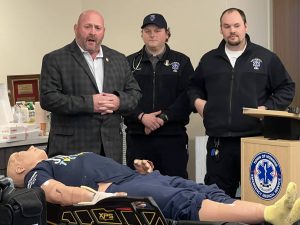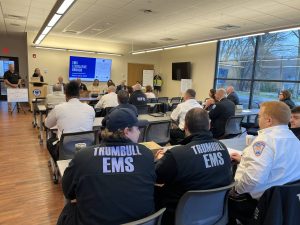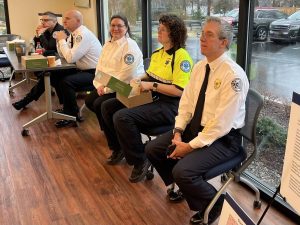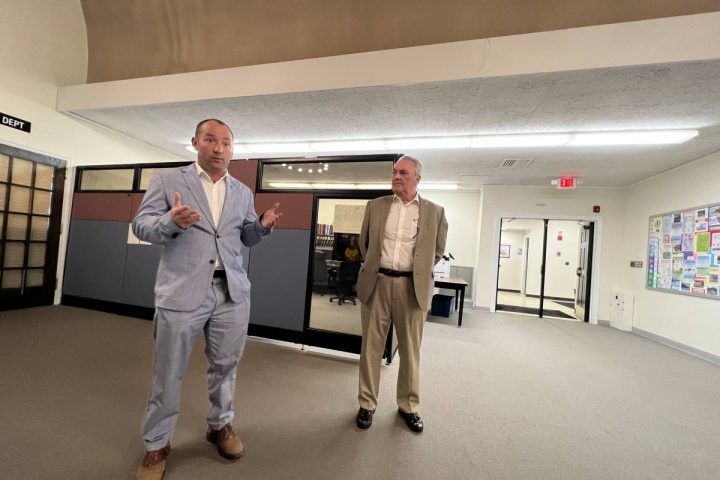MONROE, CT — Connecticut’s volunteer emergency medical service organizations, who already struggle with recruitment, are facing a dire future with less financial reimbursement for responding to calls and transporting patients to hospitals — and sometimes no reimbursement at all. A steadily rising volume of calls, due to high density housing developments, is another challenge that can sometimes overwhelm these overworked, understaffed ambulance services.
Kevin Giasullo, deputy chief of the Stratford EMS, said EMS agencies’ staffs are doing double, sometimes triple the work, adding there is a need for competitive wages and more staffing.
“You’ll see agencies close,” he said. “That’s not a threat. It’s starting to happen. We didn’t back away. We need help.”
Giasullo made those comments during the Southwest Connecticut & Southcentral Connecticut EMS Councils’ EMS Legislative Brunch, held in the classroom of the Monroe Volunteer Emergency Medical Service’s headquarters Saturday morning.
“We’re thrilled to host the region in our new facility and just appreciate all the leaders of other towns for participating,” said Monroe EMS Chief Craig Rosenberg.
Participants at the brunch included representatives of EMS agencies in Monroe, Easton, Trumbull, Shelton, Stratford, Westport, Stamford, Hamden, Essex, Seymour, West Haven, Milford and Bridgeport Hospital.

Monroe First Selectman Terry Rooney, who attended the event with his wife Nadine, thanked everyone for coming and expressed his support for the area’s first responders.
Representatives from Connecticut’s General Assembly were among a panel of speakers, including Laura Dancho (R-Stratford), Joseph P. Gresko (D-Stratford), Anne Hughes (D-135th), Sarah Keitt (D-134th), Cristin McCarthy Vahey (D-133rd), Ben McGorty (R-122nd), and David Rutigliano (R-Trumbull).
Mike Loiz, Connecticut representative of the National Association of Emergency Medical Technicians (NAEMT) and director of EMS for the town of Stratford, also participated in the panel discussion.
Leigh Goodman, president of the Southwest Connecticut EMS Council, organized the event with Bill Fitzmaurice, president of the Southcentral Connecticut EMS.
Goodman said this is the second legislative brunch, adding they will try to do these events once or twice every year. “We can talk about the good in our industry, the challenges and how to collaborate to continue to grow and succeed,” she said.
Bill Schietinger, chairman of the Connecticut EMS Advisory Board, also attended the brunch. Panera breakfast boxes and Dunkin’ Donuts coffee were provided by Bridgeport Hospital. EMS organizations in the region work under the hospital’s medical director’s license.
A communication pathway

Schietinger shared news of important bills lawmakers are considering at the State Capitol in Hartford. He said the Connecticut EMS Advisory Board helps legislators to understand the bills that affect patient care and the impact on EMS organizations.
But sometimes that communication fails.
He said one bill that would require every EMS organization to be trained on how to use nasal glucagon, a powder that treats severe low blood sugar, and to carry it in every ambulance was discussed in committee without input from the Connecticut Office of Emergency Medical Services.
Schietinger said the proposal is not only costly at around $388 per dose, but ambulances already carry it in a liquid form that is injected into a muscle.
“It will just sit in a truck unused and expire,” he said.
McCarthy Vahey, who co-chairs the legislature’s Public Health Committee, said they will review the bill requiring nasal glucagon. “Sometimes because of the volume of work we do things don’t get flagged as they should,” she explained.
She praised EMS members for the patient care they provide and promised to open up more communication with the General Assembly.
“We can form a communication pathway for the bills you care about,” she said.
Another concern Schietinger shared was a bill to get the University of Connecticut’s fire department a Primary Service Areas license for an ambulance service via the legislature, rather than the usual process under the OEMS.
“When we start legislating care outside of the medical directors, we’ll hurt patient care more,” Schietinger said.
McCarthy Vahey also vowed to follow up on the bill to give the UCONN fire department a PSA.
Falling short
 One of the biggest issues ambulance services face are significant shortages in reimbursement they receive for responding to calls. To put this into perspective, Andrew Tisdale, deputy chief of the Seymour EMS, said they write off $400,000 to $500,000 a year in lost reimbursement.
One of the biggest issues ambulance services face are significant shortages in reimbursement they receive for responding to calls. To put this into perspective, Andrew Tisdale, deputy chief of the Seymour EMS, said they write off $400,000 to $500,000 a year in lost reimbursement.
Schietinger said the state has a maximum rate ambulance services can charge for transport and private insurers usually pay EMS services less than that, negotiating it lower, while Medicare’s rate is flat and, in Connecticut, Medicaid only pays out 62 percent of what Medicare does.
Last year, Schietinger said EMS advocates tried to get Medicaid to be on par with Medicare. While the legislature did not pass anything to accomplish that, it did agree to increase it by 20 percent, which would be effective by July of 2024.
However, during this year’s budget process, Gov. Ned Lamont took that out of the budget due to spending caps and an ongoing study, according to Schietinger. Now a lobbying effort is underway to put it back in.
“We need this Medicaid increase back in — and it’s just a bandaid. It’s a tourniquet,” Schietinger said of resolving the overall problem.
If patients refuse a ride to the hospital at the scene, an ambulance service does not get reimbursed for the labor and equipment used to respond to the medical call, according to Schietinger.
Raffaella “Ralf” Calciano, of OEMS, said call volume went down at the height of the COVID-19 pandemic when more people were reluctant to be taken to the hospital, but has soared ever since.
According to a graph in the OEMS’s 2022 annual report, there was a low of 55,403 911 calls in April of 2020, which rose in the vast majority of the ensuing months, reaching a high of 83,339 calls in January of 2023. There was also an average of 7,360 refused transports a month across the state.
Schietinger said some insurance companies require prior authorization to cover transport, but if someone has chest pain and calls 911, there is no time for prior authorization. He said the ambulance service must respond.
In other cases, a patient may call 911 with a headache and ask for transport to the hospital. “We can’t refuse transport,” Schietinger said, adding some insurance companies will say that was not a medical emergency and refuse to pay.
While Connecticut just has 911, he said some states have a nurse triage line to determine the severity of a call before an ambulance is sent out. In a less serious call, a nurse can ask a patient questions over the phone and provide an Uber for medication.
Hughes said she is trying to find some flexibility around the state spending caps. Rutigliano said the caps are necessary but agreed ambulance services should be reimbursed. “I’m with you on this. It is a priority,” he said.
McCarthy Vahey agreed bringing back the 20 percent increase in Medicaid is a top priority, but acknowledged there are spending caps, so she said she could not promise it.
‘The best care we can provide’

Another effort underway is to make EMS coordinators full time state employees. There are three coordinators for Connecticut’s five regions and one woman has been coordinator of three of those regions for the past 12 years.
A representative of Milford EMS said they are facing an influx of people moving into their town, just as other agencies in the region are, and have not had an increase in personnel since 1972.
Monroe Deputy EMS Chief Rachel Murphy said more needs to be done to improve recruitment efforts for new members, and thanked EMS services from neighboring towns for assisting her town to ensure all calls are covered.
Rosenberg shared the bright side for Monroe.
“Our facility is a great example of town, state and community support,” Rosenberg said of the building project for Monroe’s EMS headquarters. “For the first time, we’re able to run classes here. That’s big for recruiting.”
Despite all of the issues EMS organizations in the state are fighting for, Goodman said, “it’s really still about the patients. It’s a calling. We all do this because we want to provide the best care. We want to keep people safe, but we’re struggling at a critical point to do that.”
All respectful comments with the commenter’s first and last name are welcome.






